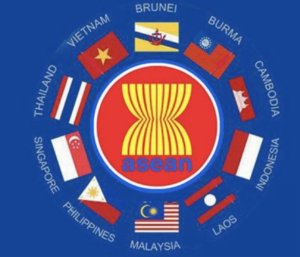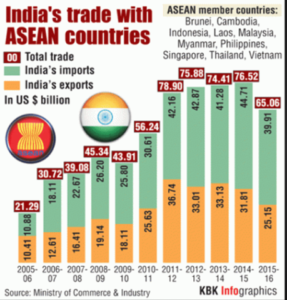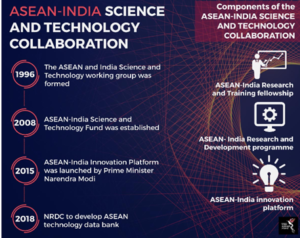India, ASEAN in Shifting Geopolitics.
Relevance
- GS 2: Bilateral, Regional and Global Groupings and Agreements involving India and/or affecting India’s interests.
- Tags: #ASEAN #GlobalSouth #GS2 #UPSC #Jakarta.
Why in the News?
Prior to the G20 Summit in India, Prime Minister Modi is scheduled to participate in the ASEAN-India and East Asia summits in Jakarta on September 6-7, with a primary focus on enhancing trade and security relationships.
Understanding ASEAN: The Association of Southeast Asian Nations
- ASEAN, which stands for the Association of Southeast Asian Nations, is a regional intergovernmental organization comprising ten member states in Southeast Asia.
- It was established on August 8, 1967, by Bangkok Declaration, with the goal of promoting political and economic cooperation, as well as regional stability and peace, among its member countries.
- ASEAN’s Motto is “One Vision, One Identity, One Community”
- ASEAN Day is celebrated on August 8th, with the ASEAN Secretariat based in Jakarta, Indonesia.
- The member states of ASEAN include Brunei, Cambodia, Indonesia, Laos, Malaysia, Myanmar, the Philippines, Singapore, Thailand, and Vietnam.
- A total of eight countries—Australia, China, India, Japan, Republic of Korea, New Zealand, Russia, and the United States—make up the Dialogue Partners.
The ASEAN Community consists of three fundamental pillars
- ASEAN Political-Security Community.
- ASEAN Economic Community.
- ASEAN Socio-Cultural Community.
The Significance of ASEAN: Advancing Regional Cooperation and Stability
ASEAN has achieved a number of significant successes in advancing regional cooperation and stability. These include
- The establishment of the ASEAN Free Trade Area (AFTA), which has created a single market for goods and services in the region
- The signing of the ASEAN Declaration on the Conduct of Parties in the South China Sea (DOC), which is a non-binding agreement to promote peaceful and cooperative relations in the South China Sea
- The establishment of the ASEAN Regional Forum (ARF), which is a forum for dialogue and cooperation on security issues in the Asia-Pacific region.
- The launch of the ASEAN Comprehensive Plan of Action (ACPA), which is a roadmap for achieving the organization’s goals for economic, social, and cultural development.
India – ASEAN Historical Background
|
ASEAN – India Sectoral Cooperation
To support cooperation activities between ASEAN and India, Govt of India has created three funds.
- ASEAN-India Cooperation Fund (AIF)
- ASEAN-India Green Fund (AIGF)
- ASEAN-India Science and Technology Development Fund (AISTDF)
Sector-Specific dialogue Mechanisms
- For Energy: East Asia Summit Energy Ministers Meeting
- Activities in the ICT domain – digital connectivity with ASEAN: ASEAN Digital Minister’s Meeting ADGMIN.
- For promoting maritime connectivity activities: ASEAN India Maritime Transport Working Group.
- For Promoting cooperation activities in the Agriculture sector: ASEAN-India Ministerial Meeting on Agriculture and Forestry.
- Delhi Dialogue, 2009: It is an annual Track 1.5 forum for discussing politico-security, economic and socio-cultural issues between ASEAN and India.
India’s Flourishing Free Trade Agreements (FTAs) with ASEAN Nations
India-Singapore CECA: Bilateral Trade Boost
- The India-Singapore Comprehensive Economic Cooperation Agreement (CECA) signed in 2005 led to significant growth in bilateral trade.
- Both nations expanded tariff concessions, liberalized export rules, and incorporated Certificate of Origin provisions to ensure balanced trade.
India-Malaysia MICECA: Strong Trade Relations Amidst Pandemic
- India and Malaysia’s Comprehensive Economic Cooperation Agreement (MICECA), established in 2011, saw reductions in tariffs for goods, services, investments, and labor movement.
- Despite the COVID-19 pandemic, bilateral trade expanded by 26% in 2021, benefiting Malaysian palm oil exporters due to reduced import duties.
India-Thailand FTA (EHS): Building Confidence and Trade
- The India-Thailand Free Trade Agreement (Early Harvest Scheme) initiated in 2006 focuses on identifying specific products for tariff reduction during ongoing FTA negotiations.
- It builds confidence between the nations, proposing tariff reductions for 82 products, spanning various sectors like agriculture, electronics, and auto parts, with an eye on improving benefits from the ASEAN-India FTA.
20th ASEAN India Summit and the 18th East Asia Summit
- The 20th ASEAN India Summit and the 18th East Asia Summit are slated for September 7 in Jakarta, at the request of President Joko Widodo of the Republic of Indonesia.
- According to the MEA Secretary (East), PM Modi will assess the development of the India-ASEAN relationship during the summit.
- This year, Indonesia is the Chair of ASEAN. The theme of their chair-ship is
‘ASEAN Matters: Epicentrum of Growth’.
- India, a founding member of the East Asia Summit, is dedicated to improving the mechanism and enhancing its capacity to address current issues.
India’s Prospects and Opportunities within ASEAN
Economic opportunities
- ASEAN is a rapidly growing economic bloc with a combined GDP of over $3 trillion.
- India is the fourth largest economy partner of in ASEAN, and the two sides have a trade volume of over $80 billion
People-to-people opportunities
- ASEAN and India share a rich history and culture.
- There are over 30 million people of Indian origin living in ASEAN countries, and there are strong links between the two regions in terms of education, tourism, and cultural exchange.
Connectivity opportunities
- ASEAN is a vast region with a diverse geography. India is well-positioned to serve as a bridge between ASEAN and the rest of Asia.
- The two sides are working together to improve connectivity through projects such as the India-Myanmar-Thailand Trilateral Highway and the ASEAN-India Maritime Corridor.
Environmental opportunities
- ASEAN and India are both facing the challenges of climate change and other environmental issues.
- The two sides are working together to address these challenges through projects such as the ASEAN-India Green Energy Corridor and the ASEAN-India Initiative on Sustainable Urbanization.
Convergence with Indo-Pacific plan
- India’s “Act East” policy and its “Indo-Pacific” strategy, which represent the convergence of regional interests, both heavily rely on ASEAN.
- Strengthening ties with ASEAN nations can act as a counterbalance to China’s influence in the area.
- ASEAN is key to India’s Indo-Pacific strategy of Security and Growth for All in the Region (SAGAR).
Connectivity with the North East
- By presenting India’s northeastern states as a centre for regional trade and commerce, connectivity projects with ASEAN can accelerate economic growth in those regions.
- ASEAN plays a critical role in supporting a rules-based security architecture in the Indo-Pacific region, which is critical for the region’s stability and development.
Navigating Issues and Challenges in India-ASEAN Relations
Nature of engagement
- India continues to interact with ASEAN countries on a bilateral rather than multilateral level.
Contradicting Regional Agreements
- Participation in other regional agreements such as the Regional Comprehensive Economic Partnership (RCEP) and the Comprehensive and Progressive Agreement for Trans-Pacific Partnership (CPTPP) diverts focus and resources away from the ASEAN-India connection.
Imbalances in Trade
- India’s trade imbalance with ASEAN has grown over time. As a result, India is concerned about the advantages of the ASEAN-India Free Trade Agreement.
- In 2021-22, ASEAN imports total $68 billion, while exports total $42 billion.
Chinese Influence Constraints
- China’s regional presence can hinder ASEAN from fully utilizing India’s potential for enhancing regional stability due to geopolitical competition and economic interests.
ASEAN indeed offers India a range of opportunities in terms of economic growth, security cooperation, and global connectivity. The strong and mutually beneficial relationship between India and ASEAN is expected to strengthen further as both sides continue to engage in collaboration and regional integration efforts.
Source: Invest India, Livemint, The print.
Mains Question
Discuss the historical evolution of India’s engagement with ASEAN countries and the significance of ASEAN in India’s foreign policy. How has this relationship evolved in recent years?






